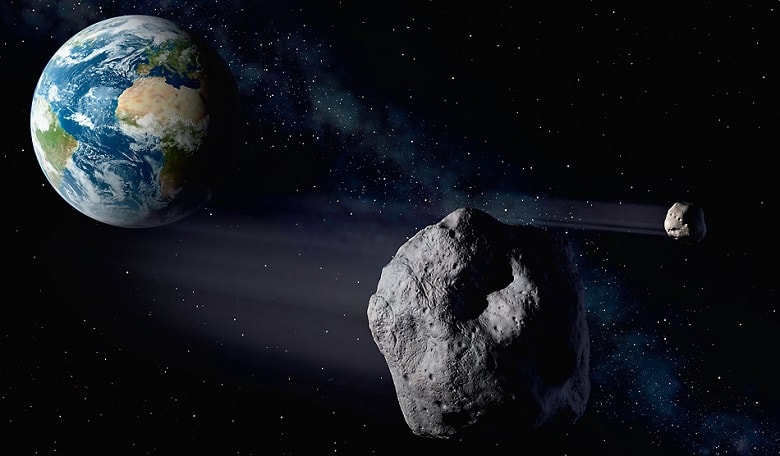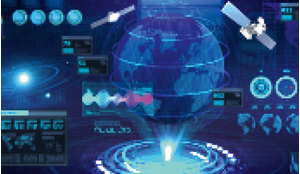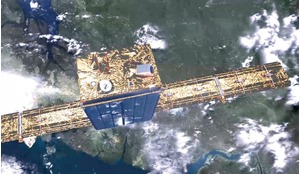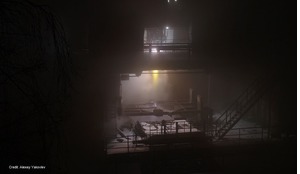Looking at the surface of our Earth, we can see scars of ancient impacts from asteroids in places like Barringer crater in Arizona or Chicxulub crater in the Yucatan. Within the past 100 years, the Earth has seen a meteorite explode in the air over Tunguska in Siberia, devastating a large area in the tundra, as well as many much smaller meteorites, such as the Chelyabinsk meteorite in 2013 that caused extensive property damage. These are the result of collisions between the Earth and the large population of much smaller near-Earth objects (NEOs).
In order to assess the risk from these NEOs, they have been discovered and followed by a number of dedicated astronomical surveys over the previous few decades. In order to extend our reach to ever-smaller but still potentially dangerous objects, a number of space and ground-based systems have been recently proposed. The largest of the planned Earth-based facilities, the Large Synoptic Survey Telescope (LSST), has just entered its construction phase after a decade of design and development.
NEOs are formally defined as objects with orbits that bring them to within 1.3 astronomical units (AU) from the Sun. An astronomical unit is defined as the mean Sun–Earth distance of 150 million km, and corresponds to about 400 times the Earth–Moon distance). NEOs are asteroids, small bodies composed predominantly of stony material ejected from the main asteroid belt between Mars and Jupiter due to gravitational and non-gravitational perturbations to their orbits, and migrating closer to Earth. Depending on details of their current orbits, NEOs are further classified into: the Atiras, whose orbits are enclosed by Earth’s orbit; the Atens and the Apollos, which cross Earth’s orbit; and the Amors, whose orbits enclose Earth’s orbit. There are about 1,000 NEOs with diameters larger than one kilometre, and the largest one is 35 km across (asteroid 1036 Ganymed). The typical lifetime of a NEO is only a few million years. NEOs are destined to collide with the Sun or a planet, or suffer another perturbation that ejects them from the solar system.
About 20 per cent of NEOs, the potentially hazardous asteroids (PHAs), are in orbits that pass sufficiently close to Earth’s orbit, to within 0.05 AU (about 20 times the Earth–Moon distance, or about 1,000 Earth radii), that orbital perturbations with timescales of a century can lead to intersections and the possibility of collision. Formally, only the Atens and the Apollos have trajectories that cross Earth’s orbit. However, the orbits of Atiras and Amors may change in the future. A collision with an object of one-kilometre diameter or more would release energy comparable to the explosion of all the world’s nuclear weapons and have catastrophic consequences for life on Earth. Such collisions happen about once or twice every million years. Smaller objects are more numerous and collisions with 100-metre-wide or larger objects happen about once every 100,000 years.
The main mode of inflicting damage for these smaller objects is large tsunamis. Very small asteroids with sizes of a few metres impact Earth about once a year. However, most objects smaller than about 20-30 metres burn up in the Earth’s atmosphere and don’t reach the ground.
Aware of the asteroid collision risk, the USCongress directed NASA, in December 2005, toimplement a NEO survey that would catalogue90 per cent of NEOs with diameters larger than140 metres by 2020 (this has typically been interpreted as applying to 90 per cent of all PHAs). The deadline was chosen to be 15 years after signing the mandate, which at the time seemed a reasonable period to build a system (either space or Earth-based) to catalogue these PHAs. The size limit and 90 per cent completeness level were chosen through a careful calculation of potential risks from impactors, weighed against the increasing costs of detecting smaller and smaller objects, as well as a consideration for previous cataloguing efforts.
The population of larger NEOs and PHAs is now fairly well known, thanks to discovery and tracking efforts from previous and ongoing surveys. Ground-based Spacewatch, LINEAR, the Catalina Sky Survey and Pan-STARRS, as well as space-based NEOWISE, have already come close to identifying 90 per cent of all PHAs larger than one kilometre in diameter (NASA’s so-called Spaceguard goal), using modest-sized (less than two-metre) telescopes. Using the detections coming from these and other telescopes, NASA maintains an automated collision monitoring system called Sentry that continually scans the most current asteroid catalogue for possibilities of future impact with Earth over the next 100 years. Currently, there are no likely impactors for that time period. The only object for which an eventual collision cannot be strongly ruled out is asteroid (29075) 1950 DA, with a possible (but not very likely) impact event in the year 2880.
However, to reach the 90 per cent completeness level for the smaller PHAs with diameters of 140m requires larger telescopes, with larger cameras, than are currently deployed in NEO-hunting. A cost-effective measure is a 10-metre class, ground-based observatory equipped with a large camera and sophisticated and robust data processing system. LSST is such a system, and sophisticated simulations of NEO/PHA populations coupled with realistic observing conditions have shown LSST is capable of fulfilling the Congressional mandate.
In contrast to the ground-based, optical LSST, space-based missions aim to detect NEOs using infrared cameras. The existing space-based mission, NEOWISE, is expected to continue until 2017, by which time it will have observed about 2,000 NEOs. The proposed next-generation space-based survey, Near-Earth Object Camera (NEOCam), would use a 0.5-metre telescope orbiting at the Sun–Earth L1 Lagrange point (about 0.01 AU from Earth towards the Sun). During a five-year baseline mission, it would aim to discover about two thirds of PHAs larger than 140m. Another proposed space-based survey, Sentinel, would place a 0.5-metre telescope into an orbit similar to that of Venus. Sentinel is anticipated to be capable of detecting 90 per cent of NEOs larger than 140m in about seven to 10 years of operation.
The thermal infrared emission from asteroids is better detected from space than from the ground, and can provide a more direct estimation of asteroid size. Depending on the orbit chosen, space-based telescopes can detect NEOs on orbits interior to the Earth more efficiently than ground-based telescopes. In practice, space-based infrared surveys and ground-based optical surveys are very complementary. By obtaining infrared plus visible light measurements, the size and albedo of the NEOs can be more accurately determined and more information about the physical properties of the NEO can be gathered. In addition, ground-based surveys are well suited for obtaining long-term observations of NEOs in order to very accurately determine their orbits.
Treasure trove
LSST is currently by far the most ambitious, multi-purpose, proposed survey of the sky. It will be a large, wide-field, ground-based imaging system designed to obtain multiple images per night, covering the sky visible from Cerro Pachon in northern Chile. The LSST design is driven by four main science themes: probing dark energy and dark matter; taking an inventory of the solar system; exploring the transient optical sky; and mapping the Milky Way. The telescope will have an 8.4-metre primary mirror, an unusually large field of view (10 square degrees, or about 50 times larger than full Moon) and a 3,200 megapixel camera. LSST is a public–private project, with the US National Science Foundation supporting the telescope and site facility construction, data management system, education and public outreach components, and with the Department of Energy supporting the camera fabrication. The construction of LSST will be completed by the end of this decade, followed by 10 years of operations.
For the theme of taking an inventory of the solar system, the goal is to better understand the process of planet formation and evolution, and the relationship between our solar system and other planetary systems. However, in the process of cataloguing and characterising about five million small bodies throughout our solar system, LSST will also play a major role in PHA impact hazard assessment and discovering NEO potential targets for spacecraft missions. Simulations show that LSST will be capable of measuring orbits for 80 per cent of PHAs larger than 140m after 10 years of operations. In addition, the completeness can be boosted to 90 per cent, with a negligible effect on other science goals, by extending the planned baseline survey by two years.
LSST is the only upcoming ground-based survey capable of reaching this completeness level due to its very large field of view. It will detect objects as small as 10m at distances as large as 0.1 AU (15 million km, or about 40 times the Earth–Moon distance) as well as 100-metre objects in orbits similar to that of Venus. In addition, observations will be also obtained at low solar elongations to improve the completeness for objects within Earth’s orbit. While such observations are less efficient due to the increased thickness of Earth’s atmosphere close to the horizon, LSST will still be remarkably sensitive.
The LSST survey will open a movie-like window on objects that change brightness, or move, on timescales ranging from 10 seconds to 10 years. The survey will have a raw data rate of about 15 TB per night, and will collect over 50,000 TB of data over its lifetime. The result will be an incredibly rich and extensive public archive, a treasure trove for breakthroughs in many areas of astronomy and physics. About 20 billion galaxies and a similar number of stars will be detected. For the first time in history, the number of catalogued celestial objects will exceed the number of living people!
LSST and its unprecedented science-ready database, with about 30 trillion time-resolved observations for 40 billion celestial sources, will significantly contribute to the worldwide democratisation of science. LSST will be in some sense an internet telescope: the ultimate network peripheral device to explore the universe, and a shared resource for all humanity.














